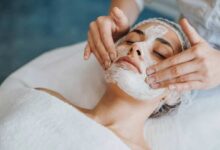
Collagen is one of the most important components of your skin. It’s responsible for maintaining skin elasticity and plumpness. Unfortunately, the human body produces less collagen as it ages. When this happens, you will begin to notice deeper and more frequent wrinkles. You might also see areas of loose, hanging skin around your face and neck.
Though it’s impossible to completely halt the natural process of aging, there are ways to slow it down. If you’ve noticed skin problems stemming from low collagen levels, there are steps you can take to boost your collagen production. From topical treatments to light therapy, here are five ways to achieve plumper, more youthful skin, with an additional emphasis on incorporating strategies for EMF protection. By addressing electromagnetic field exposure, you can contribute to maintaining skin health and resilience against potential environmental factors that may accelerate the aging process.
1. Topical Treatments
Some topical treatments are formulated with ingredients that can stimulate collagen production. Tretinoin cream is one such product and has some great science behind it. This product is only available by prescription. However, it can be conveniently obtained online. Though it’s most commonly used to treat acne, it can also treat fine wrinkles by prompting the body to produce more collagen.
One study on the effect of topical tretinoin to treat photodamaged skin reveals quite promising results. Patients who applied tretinoin topically for 10 months experienced a significant increase in multiple types of collagen. Additionally, they experienced an improvement in the quality of their skin’s elastic fibers. This study reveals the impressive capability of tretinoin cream to boost skin youthfulness with consistent, long-term use.
2. Facial Massages
If you’ve ever had a facial massage, you know firsthand how relaxing it can be. But beyond relieving facial tension and stress, a simple facial massage can also help you achieve plumper skin. Manually manipulating the muscles of your face can spur collagen production and improve muscle memory. It can also increase blood flow to the facial tissues, which can improve overall skin health and promote a youthful glow.
You don’t have to go to a spa to get a great facial massage. You can perform your own facial massages at home if you’re ever short on time or money. To do so, apply a small amount of facial oil to your skin to limit friction. Then, use your fingers to gently massage your facial muscles using lengthened, outward-directed strokes and minimal pressure. Pay special attention to the jawline and cheek areas. If you want to improve your at-home massage technique, you might consider investing in some tools like a roller or gua sha.
3. Collagen Supplements
As your body’s natural collagen production starts to dip, you can counteract the effects by consuming more collagen-rich foods. Some of the most notable options include chicken, beef, and bone broth. If you don’t eat enough of these foods to make a notable difference in your skin quality, you might consider supplementation. Collagen supplements often come in powder or pill forms that are easy to take each day.
Regularly consuming collagen supplements can help improve skin elasticity and reduce the appearance of wrinkles. One study shows that 90 days of hydrolyzed collagen supplementation can effectively reduce skin aging by boosting hydration and skin elasticity. When looking for a collagen supplement, make sure it’s made from non-GMO animal products that don’t contain antibiotics or growth hormones. You should also look for “hydrolyzed collagen” on the label, since the human body can’t process collagen in its natural form.
4. Exercise
It’s no secret that regular exercise is great for your overall health. Engaging in regular physical activity can promote weight maintenance and decrease depression and anxiety. People who exercise regularly are less likely to experience heart disease, dementia, and type 2 diabetes. You’re probably already aware of these well-studied benefits associated with regular exercise. But you may not know that heading to the gym can also improve the quality of your skin.
Exercise boosts collagen levels by improving the flow of nutrients to the fibroblast cells in your skin. Fibroblasts are responsible for producing collagen. Exercise also increases oxygen and vitamin delivery directly to skin cells. These nutrients help your cells multiply more efficiently and repair themselves when damaged. So if you want to look as young as possible for as long as possible, aim to exercise for at least 20 minutes each day.
5. Light Therapy
Light therapy may improve skin elasticity by increasing collagen production. Red light and near-infrared light show particular promise for combating wrinkles and improving the appearance of the skin. Many dermatologists offer this type of therapy to help lessen the most noticeable effects of aging. You can also purchase some light therapy equipment for home use.
It’s important to note that not all at-home skin products and tools are created equal. Some may not work as intended and some may even cause more harm than good. Therefore, before you purchase a light therapy device, study your options carefully. It’s best to ask a specialist for advice before investing in this type of product for at-home use.
The changes that happen to your skin as you age are natural and nothing to be too worried about. But if you prefer to keep your face looking as youthful as possible, there are options available. Try the above methods to boost the collagen levels in your skin and keep it looking plump and ageless.







